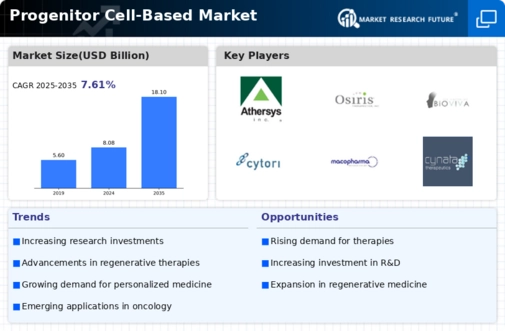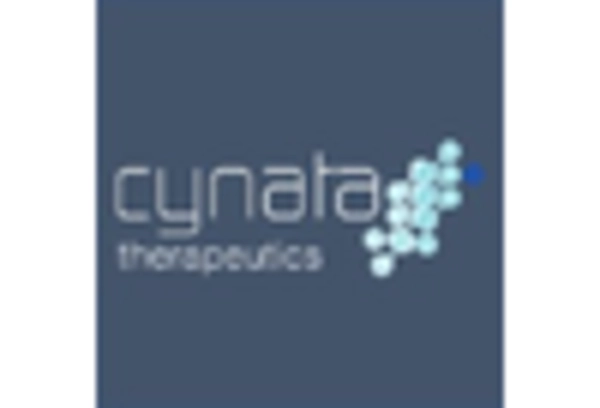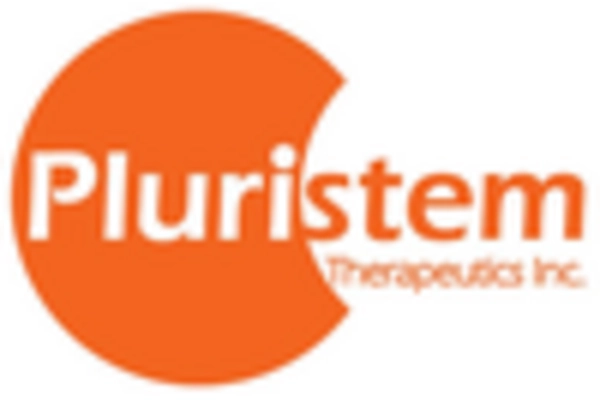Collaborative Research Initiatives
Collaborative research initiatives are emerging as a key driver in the Progenitor Cell-Based Market. Partnerships between academic institutions, research organizations, and biotechnology companies are fostering innovation and accelerating the development of progenitor cell therapies. These collaborations often lead to shared resources, expertise, and funding, which can significantly enhance research outcomes. As the complexity of progenitor cell applications increases, such collaborations are likely to become more prevalent. This trend not only boosts the efficiency of research but also contributes to the overall growth of the Progenitor Cell-Based Market, as new therapies and technologies are developed.
Rising Demand for Regenerative Medicine
The Progenitor Cell-Based Market is experiencing a notable surge in demand for regenerative medicine. This trend is largely driven by the increasing prevalence of chronic diseases and the aging population, which necessitate innovative treatment options. Progenitor cells, known for their ability to differentiate into various cell types, are pivotal in developing therapies aimed at tissue repair and regeneration. According to recent estimates, the regenerative medicine market is projected to reach substantial figures, indicating a robust growth trajectory. This rising demand is likely to propel investments in progenitor cell research, thereby enhancing the overall landscape of the Progenitor Cell-Based Market.
Increased Funding for Stem Cell Research
The Progenitor Cell-Based Market is benefiting from increased funding directed towards stem cell research. Governments and private organizations are recognizing the potential of progenitor cells in addressing unmet medical needs. This influx of financial resources is facilitating extensive research initiatives, clinical trials, and the development of novel therapies. Reports indicate that funding for stem cell research has seen a significant rise, which is expected to continue in the coming years. This financial support is crucial for advancing the understanding of progenitor cells and their applications, thereby fostering growth within the Progenitor Cell-Based Market.
Technological Advancements in Cell Therapy
Technological innovations are significantly shaping the Progenitor Cell-Based Market. Advances in cell culture techniques, gene editing technologies, and bioprocessing methods are enhancing the efficiency and efficacy of progenitor cell therapies. For instance, the advent of CRISPR technology has opened new avenues for genetic modifications, potentially increasing the therapeutic applications of progenitor cells. Furthermore, automation in cell manufacturing processes is expected to reduce costs and improve scalability, making therapies more accessible. As these technologies continue to evolve, they are likely to drive the growth of the Progenitor Cell-Based Market, attracting both researchers and investors.
Growing Awareness and Acceptance of Cell-Based Therapies
Public awareness and acceptance of cell-based therapies are on the rise, positively impacting the Progenitor Cell-Based Market. As more patients and healthcare professionals become informed about the benefits of progenitor cell therapies, the demand for such treatments is likely to increase. Educational campaigns and successful case studies are contributing to this growing acceptance. Moreover, as regulatory bodies continue to approve more progenitor cell-based therapies, confidence in these treatments is expected to strengthen. This shift in perception is crucial for the expansion of the Progenitor Cell-Based Market, as it encourages investment and innovation.


















Leave a Comment